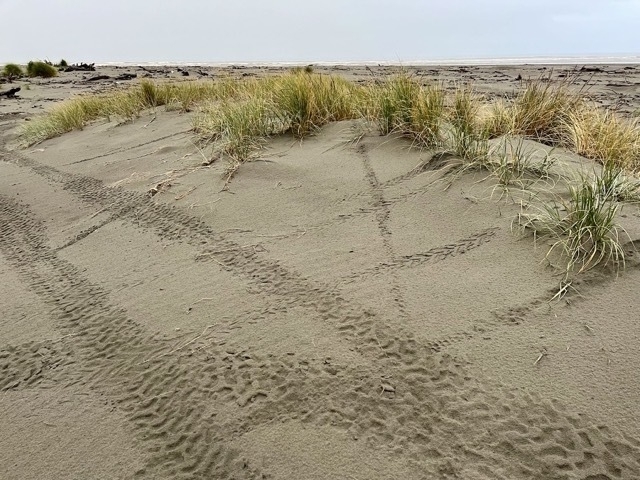
Motorbike and quad bike racing; ripping up the dunes — bad behaviour by a few over the Easter holidays was damaging and dangerous.
Between the sea and the settlement of Waikawa Beach lie the sand dunes. Grasses such as Spinifex, Pīngao and Marram help hold the sand, binding it in place. Spinifex and Pīngao in particular reach out towards the sea and help grow the dunes laterally.
The dunes help protect the settlement and provide habitat for birds and other animals to nest and breed and live.
In turn, driftwood helps protect the dunes and collects sand and provides shelter for wildlife..
The area roughly marked on the aerial photo at the top of this post is on the seaward side of where an enormous investment of time, money and energy has gone into planting native beach grasses in the last decade. That area is commonly home to Pied Oystercatchers, South Island Oystercatchers, Pied Stilts, Banded Dotterels, New Zealand Dotterels and others
In the last 5 years in particular new dunes have started to form and be held together by grasses, both planted and self-seeded.
This growth in encouraging and important. It enhances Waikawa Beach and deserves protection. Most people find it an easy area to avoid — walking or driving past.

So it was utterly disappointing to discover that during the Easter school holidays numerous vehicles (or perhaps a few vehicles numerous times) had driven through and between the new dunes, across the summer bird-breeding area and even over the tops of the young dunes, sometimes ripping out chunks. There were clearly tracks from motorbikes and from 4-wheeled vehicles, some very heavy.

Criss-crossing and circular tracks, layered one on top of another show this wasn’t someone just passing through, but a deliberate use of the area as some kind of vehicle playground.
Dunes are fragile areas, easily damaged, especially by vehicles. Every Council in the country that has policies about vehicles on beaches aims to keep vehicles off dunes.

Mostly folks driving vehicles along Waikawa Beach stick to the high-tide mark and drive slowly and carefully; in this case though the rules were broken and damage was done.
Also over Easter, on the Saturday, apparently the beach was used in a highly dangerous manner as a racetrack. I read from locals the following lightly edited exchange (names removed by me):
A: So dangerous this afternoon
B: Not sure if it was dodgem’s or bull-rush trying to go down for a swim. Quadbikes to the left of me, motorbikes to the right, stuck in the middle …
A: 8 bikes and quads racing. Excessive speed from dunes to sea. Drivers (children) looking back to see each other so not looking forward. I was worried for their safety and my own.
C: Were people driving from the dunes to the sea or did you mean they were going parallel to the sea but filling up all the space between dunes and sea?
A: They were driving parallel to sea and filling the beach from dunes to sea
Perhaps it’s time for yet another reminder, to be passed along by the many considerate drivers to those few who don’t understand the law: The beach is a road
(Land Transport Act 1998). That means that drivers must be licensed and appropriately equipped (eg wearing bike helmets) and vehicles must be registered and warranted. It also means sticking within the speed limit and obeying all other laws relating to driving on a road.
And if anyone wants to change how Waikawa Beach is used by vehicles — that falls within the scope of the Horowhenua District Council and Horizons Regional Council:
under the Land Transport: Setting of Speed Limits Rule 2017. The actual wording of the Act is that ‘A road controlling authority may make any bylaw it thinks fit … for prohibiting or restricting the use of vehicles on beaches’. Some territorial authorities have set speed limits on all beaches in their area.
Kāpiti Council, for example, bans all motorbikes from all its beaches:
15.2 Two-wheeled (road or off-road) motorcycles or mopeds are not permitted to drive on any part of the beach.